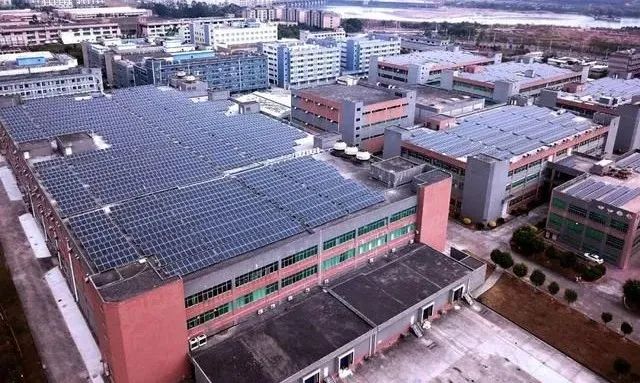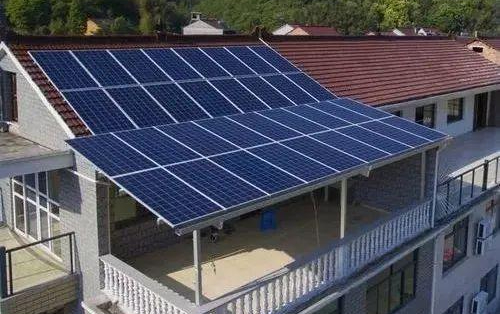The vast majority of industrial and commercial photovoltaics users install photovoltaic modules on their roofs, which can not only help owners save on electric bills but also optimize the use of roof space and provide cooling. In this article, we will discuss some of the most important things to keep in mind when installing a PV plant on a flat roof.
Key 1: Which Installation Method to Use

The methods of installing photovoltaic modules on different types of roofs vary. Common installation methods include Addition Type, Ballast Type and Pile Foundation Type.
If the roof is made of color steel tiles the Addition Type is generally considered, with photovoltaic components directly installed on the color steel tile. Typically, a color steel tile roof does not have a parapet wall, and the tiled type has both the best windproof effect and is the safest. In addition, the color steel tile roof also has a certain inclination angle. Although it may not be the best inclination angle for photovoltaic power generation, the transformation cost should be taken into account when increasing the angle.
For cement roofs, which are usually flat, the common installation methods are Ballast Type and Concrete Pile Foundation Type, as shown in the picture above.
Most often, building owners are discouraged from drilling holes in concrete flat roofs as a matter of taking into account the structural strength of old buildings or a change in the roof’s waterproofing performance. This is why the Ballast and Pile Foundation Type installations are chosen for these roofing jobs.
Since the Ballast Type installation method has no anchor connection with the roof, windproof treatment can be considered on the side, especially for the cement roof without parapets.
The main purpose of the concrete base is to ensure that the support system remains intact, even during stormy seasons. It ensures a good installation without causing roof water leaks, and can also improve the efficiency of the solar modules and reduce the shielding of the sun by the parapet.
Key 2: Flat Roof Does Not Mean Tile Installation

Tile installation is the most natural way to install photovoltaic modules on a flat roof. Not only can the installation amount/area be maximized, but it is also possible to use photovoltaics as a roof ceiling to increase the space area.
Installing photovoltaic equipment on a flat roof does not mean that you should set its inclination angle to 0 degrees. Also, tile installation should be avoided as you need to consider many factors, including:
1. The tiled components often accumulate dust which can cause 10% or even 30% of the power generation loss.
2. Tile components are more inconvenient to clean, and any accumulated water is difficult to drain.
3. Compared with inclined installation, the power generation will be reduced.
4. The period of return on investment will likely be longer.
5. It may not be possible to remove dust deposits by natural rainfall.
Taking a look at inclination, by simulating using a 11.2kWp solar system with the inclination angles of 10, 5 and 0 degrees respectively, we see that there is a significant difference in power generation between inclined installation and pure tile installation photovoltaic arrays.
The simulation test results show that if the inclination angle is 0 degrees, the annual power generation of the 11.2kWp solar system is about 13,480.3kWh; if the inclination angle is 5 degrees, the annual power generation of the system reaches 14,066.9kWh, and when the inclination angle reaches up to 10 degrees, the annual power generation of the system goes up to 14,520kWh.
We can see from the results that for every 5 degrees increase in the inclination angle the 11.2kWp solar system increases the power generation by 500kWh per year (note: after 15 degrees, the increase will be significantly reduced, and it will be even lower after the optimal inclination angle is exceeded). What’s more, the simulation tests have not taken into account the loss of power generation due to fouling (unclear. Does this mean fouling from things like dust? bad installation?) during installation at low inclination angles.
If you are unable to install the photovoltaics at the optimal inclination angle, it is still recommended that the installation inclination angle be as high as possible. If it is necessary to use tile installation, it is recommended to keep the installation inclination angle between 5-10 degrees, which is enough for flat roofs. For color steel tile roofs, an extra 3 degrees of inclination is also recommended. Compared with the extra cost of increasing the inclination angle, it is a good choice to research and go with the best installation recommendations.
Key 3: Must Consider Wind Speed If Installing on a Flat Roof

The possible maximum wind speeds that a roof may be subject to must be considered at the design stage of the solar system, especially in areas with wind speeds exceeding 180km/h (note in the US mph is used, so 180km/h is about 120 mph). Normally, the lifespan of a photovoltaic system is 25 years, but preparation for rare weather events is a must!
With the quality of modern components and building techniques it’s easy to get complacent about the durability of roofs and solar power systems. Yet Mother Nature always has her surprises. During a 2021 typhoon in Nantong, China, winds of over 165km/h were recorded, resulting in extensive damage throughout the region including solar photovoltaic and solar water heaters blown off roofs. It was a once in a half-century storm, and it demonstrated how important proper planning and installation is to constructing a solar power system that will last for decades.
Ordinary solar power generation systems installed on flat roofs are built to withstand wind speeds up to 160km/hr, but if there is no parapet wall to block the wind, photovoltaic modules arrays are still vulnerable to sudden wind blasts and excess speeds caused by area airflow patterns. Therefore, the selection and structural design of solar power generation support systems, as well as the design of ballast or concrete foundation strength, relies on the work and expertise of professional installation companies. Taking the time to research and chose the right company is vital, and will pay off both in photovoltaic structure and function for years to come.
We hope you enjoyed this basic guide to what to think about when considering photovoltaics. For more information about our products and systems, please contact us via Email: howard@recreen.com